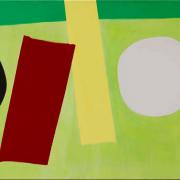
'My pictures have no hidden meaning. To understand, all you have to do is look.'
So writes John McLean in the disarmingly clear, five-sentence catalogue description of his paintings at the Union Gallery this month.
Mark of Beauty eschews some of the more eye-catching fads you’ll find in the 2012 Art Festival to focus unapologetically on contemporary abstract painters working at different stages of their careers; Scots all by birth, blood, residence or education.
The show has been curated by writer and academic art historian Bill Hare, whose introduction provides a thoughtful and (even for the non-expert reader) understandable account of how abstract painters create and how their audiences may respond. In 'Makars of Beauty' he examines the 'dialectic between plastic form and rhetorical content', and identifies four levels of artistic language:
- innate expressiveness communicating spiritual, psychological or physical enlightenment
- different tongues – like English and Scots, or Cubism and Impressionism
- dialect inspired by the particular circumstances of an artist’s background, taste and surroundings
- tone of voice peculiar to each artist.
Some familiarity with these ‘bearings’ will deepen an appreciation of the abstract works on show here, argues Hare. But he is quick to point out that ‘semantic meaning or conceptual interpretation’ are not the whole story: ‘By their arresting and engaging presence, [works of art] contain and convey their own significance within themselves through the process of their own making.’
Which brings us back to John McLean and his three large paintings at the far end of the gallery. McLean is one of the better known of the artists here, having exhibited widely and prestigiously since his first solo show in 1975. However, these works do not shriek for attention. For all their colourful spontaneity, I found them engagingly modest, controlled, and self-assured. In ‘Acrobat’ (above) and 'Balmirmir' (below) the contrasting colours, tones, shapes and spaces convey for me something akin to the rhythmic satisfactions of music.
[img_assist|nid=3253|title=|desc=|link=node|align=middle|width=640|height=320]
A kind of modesty is also apparent in the works of Russell Colombo, who likens his approach to turning away from categorising the macro world and instead admiring the complexities apparent through microscopic study. His mixed media and collage pieces – like the subtle, bark-like textures of 'Kypemuir' and 'Mossplatt' (below) – ‘have no edge, are not static and within the confines of the frame suggest to me the Buddhist awareness that “This Moment Contains all Moments”’. In a sense they also contain all paintings, being partially constructed from torn shreds of the artist’s previous works.
[img_assist|nid=3254|title=|desc=|link=node|align=middle|width=640|height=602]
Similar interests in the fragmentary ‘unfinished and infolding’ nature of painting appear in the work of Claire Wardman, whose ‘Tatuitpo’ is another highlight of the show. She draws inspiration from the patina of paint on the structure of her Cornish studio, where a combination of other painters’ and fishermen’s spillages and the effects of weathering provide ‘a source of many authors, a hinge, from artist to artist’.
[img_assist|nid=3249|title=|desc=|link=node|align=middle|width=640|height=640]
I particularly enjoyed the intriguing three-dimensional undulations of her ‘Leda Series’ (mixed media on paper; see below), where feathery whites, inky blacks and hints of pink contrast with the flat, hard, sharp edges of the frame and glass. Rather unsettlingly, they remind me somehow of whalebone corsets bursting asunder.
[img_assist|nid=3257|title=|desc=|link=node|align=middle|width=457|height=640]
For Zara Idelson – who graduated from the Glasgow School of Art only last year – figurative and abstract approaches are not mutually exclusive. Her paintings are about the act of painting itself, its spontaneous and accidental qualities in creative tension with the weight of artistic tradition. The deceptive simplicity of ‘The Guide’ (below) I found very appealing.
[img_assist|nid=3258|title=|desc=|link=node|align=middle|width=480|height=640]
A single work by Alan Shipway is typically informed by his practice of scrupulous reduction. Shipway strips away, seeking always to pare down in search of what is necessary and essential. His ‘Halcyon River’ (below) is mysteriously, exquisitely serene. It could hardly be more different to the exuberant vulcanism of Fred Pollock’s ‘Etna’, or Iain Robertson’s deliciousy thick and sensual use of impasto.
[img_assist|nid=3259|title=|desc=|link=node|align=middle|width=513|height=640]
Four works in the exhibition by local artist Trevor Jones have generated considerable attention. At one level, the apparently pixilated canvases refer back by name and palette to famous Scottish painters of the past, including Broughton’s own Alexander Nasmyth (Issues 181, 183; below). Three of the painters featured were nominated by Facebook poll, although at that stage Jones did not reveal how he would use the results. At another level, the works are artfully disguised QR codes which can link the viewer, via a modern mobile phone scan, to a website outwith the gallery space.
Here (www.scottishabstract.com) there exists an alternative gallery, an alternative artistic forum in which Hare's introduction, 3 essays and a short story inspired by the exhibition can be perused, where interested individuals can leave comments, and where anyone can post examples of their own work. The process represents an interesting and collaborative fusing of media, an experiment which – with its elastic approach to creative control – seeks to dissolve conventional frames and looks set to evolve in unexpected and thought-provoking ways. AM
[Mark of Beauty continues at the Union Gallery, 45 Broughton Street, until 3 September.]
[img_assist|nid=3251|title=|desc=|link=node|align=left|width=640|height=640]